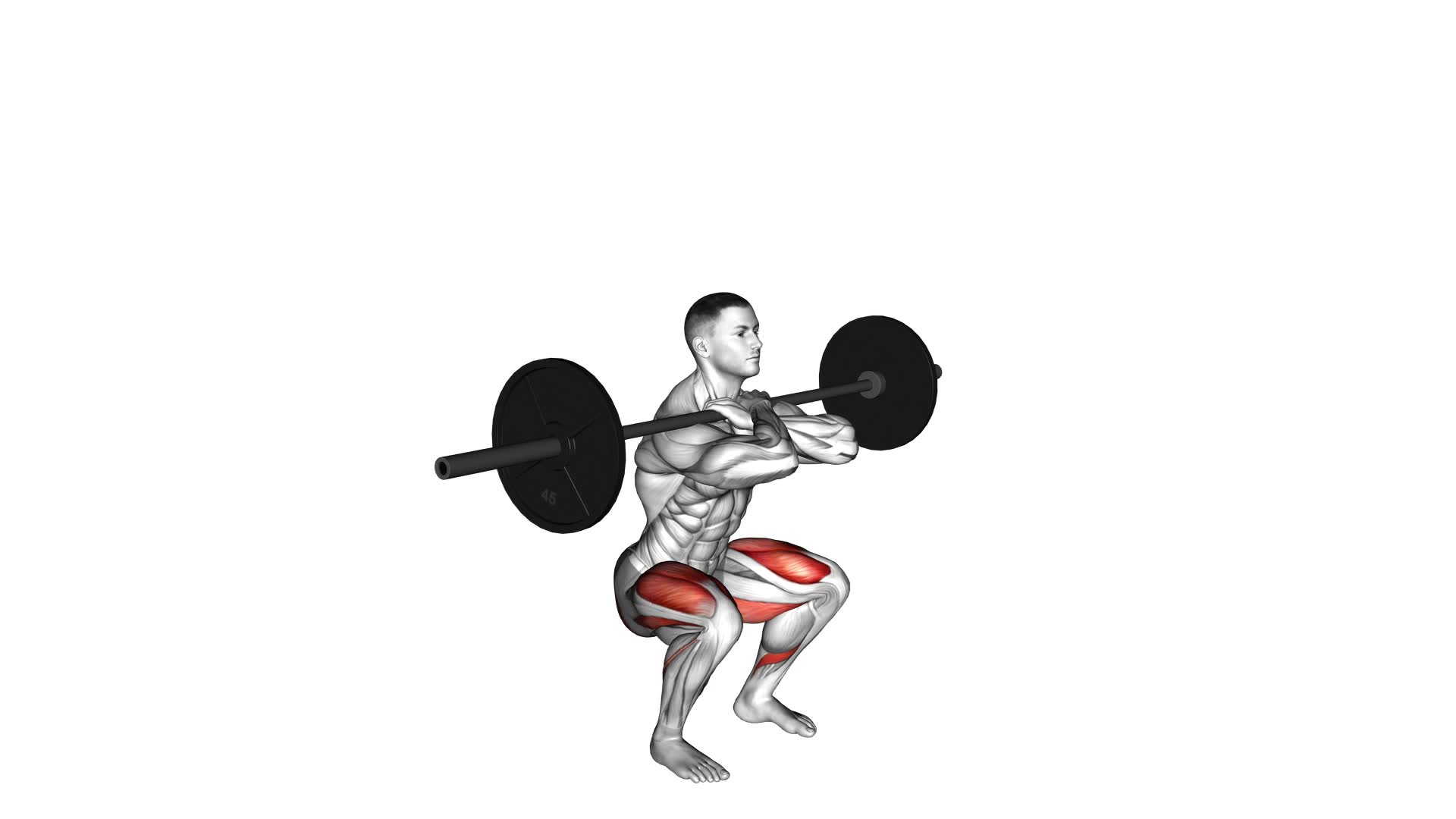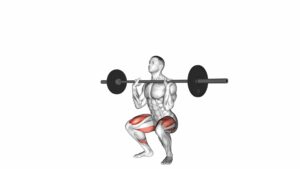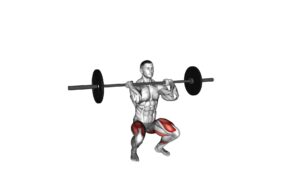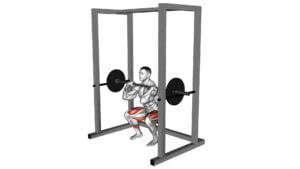Barbell Front Squat – Video Exercise Guide & Tips

Struggling to nail the perfect form for your Barbell Front Squat? You’re not alone. The front squat is an overlooked yet powerful weightlifting exercise that can strengthen your quads and enhance overall body stability.
Watch This Exercise Video
This blog will guide you step by step through videos and tips on correct front squat technique, common mistakes to avoid, various modifications you may try, and how to incorporate it efficiently into your workout routine.
Get ready to kick-start a new level of strength training!
Key Takeaways
- The barbell front squat is an effective exercise for strengthening the quads and improving core stability.
- It is important to maintain proper form and technique, including keeping your chest up, engaging your core, and avoiding common mistakes such as rounding your back or letting your knees cave inwards.
- Variations and modifications, such as sandbag front squats or dumbbell goblet squats, can help add variety to your workout routine and target different muscle groups.
- Incorporating front squats into your workout routine with recommended rep and set ranges can help maximize results.
The Benefits of the Front Squat
The front squat offers several benefits, including building quad strength and size, improving core stability, and being a great option for beginners.
Builds quad strength and size
Executing a barbell front squat regularly makes your quadriceps work overtime. This intense engagement of the quads results in increased strength and muscle size over time. It’s not just about appearances, though.
Stronger quadriceps enhance your overall physical capabilities, boosting performance in various sports and daily activities. Whether you’re sprinting for that bus or hitting a new personal record at the gym, powerful quads will always have your back… or rather, your front!
Improves core stability
Improving core stability is one of the key benefits of performing front squats. As you lower down into the squat position, your abdominal muscles, obliques, and lower back all work together to maintain a stable torso.
This not only helps with balance and control during the exercise but also carries over to other movements and activities in daily life. By strengthening your core through front squats, you can improve your overall posture and reduce the risk of back pain or injuries.
Additionally, having a strong core can enhance your performance in various sports and physical activities that require power from the middle part of your body.
Great for beginners
The front squat is a great exercise for beginners to incorporate into their workout routine. It helps build strength in the quadriceps while also improving core stability. By using a barbell across your shoulders, you can properly perform this exercise and reap maximum results.
With its emphasis on correct form and technique, the front squat allows beginners to develop proper movement patterns from the start. This exercise is not only effective but also provides improved familiarity with other variations of squats, making it an excellent choice for those new to weightlifting and strength training.
How to Properly Perform a Front Squat
To properly perform a front squat, it is important to maintain correct form and technique throughout the exercise.
Correct form and technique
To perform a barbell front squat with maximum results, it is crucial to master the correct form and technique. Start by standing with your feet shoulder-width apart and place the barbell across the front of your shoulders, ensuring that your elbows are pointing forward.
Keep your chest up and engage your core as you lower into a squat position, making sure that your thighs are parallel to the ground. Push through your heels to return to the starting position.
Remember to maintain an upright posture throughout the movement, keeping your back straight and avoiding rounding or arching. By focusing on proper form, you can effectively target your quads and build strength in this key exercise for leg development.
Common mistakes to avoid
To get the most out of your front squat and prevent injury, it’s important to avoid common mistakes. First, make sure to maintain proper form and technique throughout the exercise.
Keep your chest up, back straight, and hips squared. Avoid rounding your back or letting your knees cave inwards. Another mistake to watch out for is using too much weight. Start with a manageable load and gradually increase as you build strength and improve familiarity with the movement.
Lastly, don’t rush through the exercise. Take your time to lower into the squat position and then push through your heels to come back up.
In addition to these common mistakes, it’s also crucial to pay attention to wrist positioning during front squats. Many people tend to grip the barbell with their wrists bent backward excessively which can cause discomfort or strain on the wrists over time.
To avoid this issue, focus on keeping your wrists straight throughout the movement by engaging proper wrist mobility techniques such as stretching exercises before performing front squats.
How to use straps for grip assistance
Using straps for grip assistance can be a game changer when it comes to performing front squats. To use straps, simply loop them around the barbell and then wrap them securely around your wrists.
Make sure the straps are tight enough so that they provide you with the extra support you need. By using straps, you can alleviate some of the stress on your fingers and forearms, allowing you to focus more on maintaining proper form and maximizing your squat depth.
This grip assistance technique is especially helpful if you have limited wrist mobility or find it challenging to hold onto the barbell comfortably. Give it a try and experience how straps can enhance your front squat performance!
Variations and Modifications for Front Squats
Discover how you can switch up your front squat routine with sandbag front squats, dumbbell goblet squats, dual front rack squats, and more to maximize your leg workout! Read on for effective variations and modifications that will challenge your muscles in new ways.
Sandbag front squats
Sandbag front squats are a challenging variation of the traditional front squat exercise. Instead of using a barbell, you’ll be holding onto a sandbag across your shoulders as you perform the squat.
This increases the instability and forces your core muscles to work even harder to maintain proper form. Sandbag front squats also require more upper body strength to stabilize the weight, making them a great exercise for building overall strength and stability.
Incorporating sandbag front squats into your workout routine can help improve your lower body strength, balance, and coordination. Plus, they add variety and excitement to your workouts!
Dumbbell goblet squats
To add variety to your front squat routine, you can try dumbbell goblet squats. This exercise involves holding a single dumbbell close to your chest while performing the squat movement.
It helps target and strengthen your quads, glutes, and core muscles. To perform a dumbbell goblet squat, stand with your feet shoulder-width apart and hold the dumbbell vertically against your chest.
Lower yourself into a squatting position by bending at the knees and hips until your thighs are parallel to the ground. Keep your back straight throughout the movement and engage your core for stability.
Push through your heels to return to the starting position. Dumbbell goblet squats provide an effective alternative to barbell front squats without compromising on building strength in key muscle groups.
In addition to being a great variation for front squats, dumbbell goblet squats have other benefits as well. This exercise helps improve posture by promoting good spinal alignment during the movement.
Dual front rack squats
Performing dual front rack squats is a great way to challenge your lower body and core strength. In this variation, you hold two dumbbells or kettlebells in the front rack position while performing the squat movement.
This exercise not only targets your quadriceps and glutes but also engages your upper back muscles as you maintain a strong posture. By using weights in both hands, you add an extra level of difficulty and stability requirement to the traditional front squat.
Incorporating dual front rack squats into your workout routine can help increase overall strength and improve balance and coordination.
Front rack carries
Front rack carries are a great exercise to improve your core strength and stability. To perform front rack carries, simply hold a barbell or dumbbells across the front of your shoulders and walk for a certain distance or time.
This exercise engages multiple muscle groups, including your quadriceps, hamstrings, glutes, core, and upper back. It also helps improve your grip strength and overall posture. Front rack carries can be easily incorporated into your workout routine as an additional challenge to traditional squats or lunges.
So grab those weights and start walking to take your fitness to the next level!
Top 10 Front Squat Workouts
Incorporate front squats into your workout routine to target specific muscle groups and maximize results. Recommended rep and set ranges will ensure proper intensity for an effective front squat workout.
Incorporating front squats into your workout routine
Incorporating front squats into your workout routine can be a great way to maximize your results. This exercise targets multiple muscle groups, including the quads, glutes, and core.
By performing front squats regularly with proper form, you can build strength and size in your lower body while improving overall stability. Whether you’re a beginner or an experienced lifter, adding front squats to your workouts can help you achieve better balance and develop functional strength.
Experimenting with variations such as barbell front squat with dumbbells or using different grips can also provide new challenges and keep your workouts fresh. So give front squats a try and see how they can take your fitness journey to the next level.
Targeting specific muscle groups
The front squat is a highly effective exercise for targeting specific muscle groups in the lower body. When performed correctly, it primarily works the quadriceps, or the muscles at the front of your thighs.
Additionally, it also engages your glutes and hamstrings to a lesser extent. By incorporating front squats into your workout routine, you can specifically target these muscle groups and work towards building strength and size in your legs.
Whether you’re looking to improve your sports performance or enhance your overall fitness level, including front squats in your training regimen can help you achieve maximum results.
Recommended rep and set ranges
To get the most out of your front squat workouts, it’s important to follow recommended rep and set ranges. Aim for 3-5 sets of 8-12 reps per set. This range allows you to build strength and endurance while also challenging your muscles effectively.
Remember to adjust the weight accordingly so that you’re able to complete each set with proper form. By following these guidelines, you’ll maximize the benefits of front squats and see progress in your quad strength and overall fitness levels.
Front Squats vs. Back Squats: Which is Better?
Discover the differences, benefits, and drawbacks of front squats and back squats to determine which exercise is best suited for your fitness goals.
Differences between the two exercises
Front squats and back squats are two popular exercises that target different muscle groups and have distinct variations in form and technique. One key difference is the placement of the barbell.
In front squats, the barbell is held across the front of your shoulders, resting on your clavicles. This positioning engages your core muscles more intensely and places greater emphasis on quad strength.
On the other hand, back squats involve placing the barbell across your upper back, allowing for a wider stance and targeting your glutes and hamstrings to a greater extent. Additionally, due to differences in weight distribution, front squats require greater ankle mobility while back squats rely more heavily on hip flexibility.
Benefits and drawbacks of each
Front squats and back squats both offer unique benefits and drawbacks. The front squat is excellent for targeting the quadriceps, building strength and size in the legs. It also improves core stability due to the position of the barbell across your shoulders.
Beginners find it easier to learn proper form and technique with front squats compared to back squats. However, front squats may be challenging for those with limited wrist mobility or T spine mobility.
On the other hand, back squats primarily target the glutes and hamstrings while allowing for heavier weights to be lifted. They provide a more natural posture with weight on your upper back but require better hip flexibility than front squats.
Which one is best for your fitness goals?
The choice between front squats and back squats ultimately depends on your specific fitness goals. If you’re looking to build quad strength and size, improve core stability, or are a beginner just starting out, front squats may be the better option for you.
On the other hand, if you want to target your glutes and hamstrings more effectively or lift heavier weights, back squats might be more suitable. Consider your goals and preferences when deciding which variation to incorporate into your workout routine.
Conclusion
Mastering the barbell front squat can take your leg workout to the next level. By following proper form and technique, you will build strength in your quads, improve core stability, and see maximum results.
With various variations and modifications to choose from, this exercise can be tailored to fit any fitness goal. So grab a barbell, watch our video tutorial, and start incorporating the barbell front squat into your routine for an effective lower body workout.
FAQs
1. What is a barbell front squat?
A barbell front squat is an exercise that works various muscles, using proper form to hold the weight across your shoulders and squat down.
2. How can I avoid mistakes in performing a front squat?
By watching video tutorials or reading exercise guides, you can learn the right way to do a barbell front squat and thus avoid common mistakes.
3. Are there any alternatives to doing the traditional Barbell Front Squat?
Yes! If you’re seeking variations or alternatives, consider exercises like dumbbell front squats or try out different grip styles such as cross grip.
4. How does enhancing T spine, hip and ankle mobility help with squats?
Improving your T spine mobility drills along with hip and ankle flexibility benefits your ability to perform effective front squats by providing better range of motion.
5. What other information can be gleaned from an Exercise guide & Video tutorial for Barbell Front Squat?
They provide useful fitness tips including proper techniques, methods to include it in workouts effectively and highlighting muscles worked during this specific type of barbell squat.

Author
Years ago, the spark of my life’s passion ignited in my mind the moment I stepped into the local gym for the first time. The inaugural bead of perspiration, the initial endeavor, the very first surge of endorphins, and a sense of pride that washed over me post-workout marked the beginning of my deep-seated interest in strength sports, fitness, and sports nutrition. This very curiosity blossomed rapidly into a profound fascination, propelling me to earn a Master’s degree in Physical Education from the Academy of Physical Education in Krakow, followed by a Sports Manager diploma from the Jagiellonian University. My journey of growth led me to gain more specialized qualifications, such as being a certified personal trainer with a focus on sports dietetics, a lifeguard, and an instructor for wellness and corrective gymnastics. Theoretical knowledge paired seamlessly with practical experience, reinforcing my belief that the transformation of individuals under my guidance was also a reflection of my personal growth. This belief holds true even today. Each day, I strive to push the boundaries and explore new realms. These realms gently elevate me to greater heights. The unique combination of passion for my field and the continuous quest for growth fuels my drive to break new ground.







